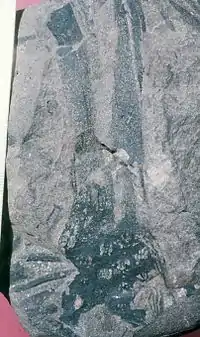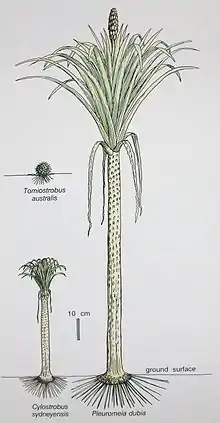Pleuromeia dubia
Pleuromeia dubia is a tall species for the genus, with distinctive elongate leaf scars, and known from the Early Triassic of Australia and South Africa. Like other species of Pleuromeia it was a survivor of the marked greenhouse spike at the end of the Early Triassic.[2]

leafy apex of Pleuromeia dubia from the Early Triassic Newport Formation near Newport, NSW
| Pleuromeia dubia | |
|---|---|
 | |
| Reconstructions of extinct lycopsids Pleuromeia dubia and Cylostrobus sydneyensis (Pleuromeiaceae and Tomiostrobus australis (Isoetaceae) all from the Early Triassic Gosford and Newport Formations of the Sydney Basin, NSW, Australia.[1] | |
| Scientific classification | |
| Kingdom: | Plantae |
| Clade: | Tracheophytes |
| Clade: | Lycophytes |
| Class: | Lycopodiopsida |
| Order: | †Pleuromeiales |
| Family: | †Pleuromeiaceae |
| Genus: | †Pleuromeia |
| Species: | †P. dubia |
| Binomial name | |
| †Pleuromeia dubia Retallack 1995 | |
See also
References
- Retallack, Gregory J. (1997). "Earliest Triassic origin of Isoetes and quillwort evolutionary radiation". Journal of Paleontology. 7 (3): 500–521.
- Retallack, Gregory J. (2013). "Permian and Triassic greenhouse crises". Gondwana Research. 24: 90–103. doi:10.1016/j.gr.2012.03.003.
This article is issued from Wikipedia. The text is licensed under Creative Commons - Attribution - Sharealike. Additional terms may apply for the media files.